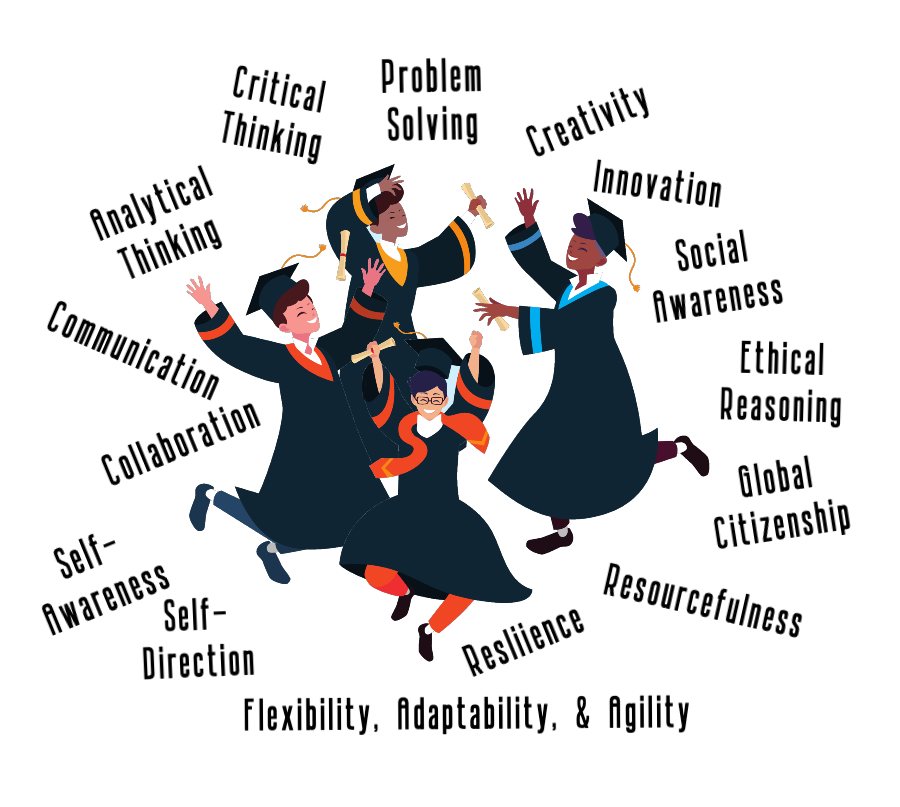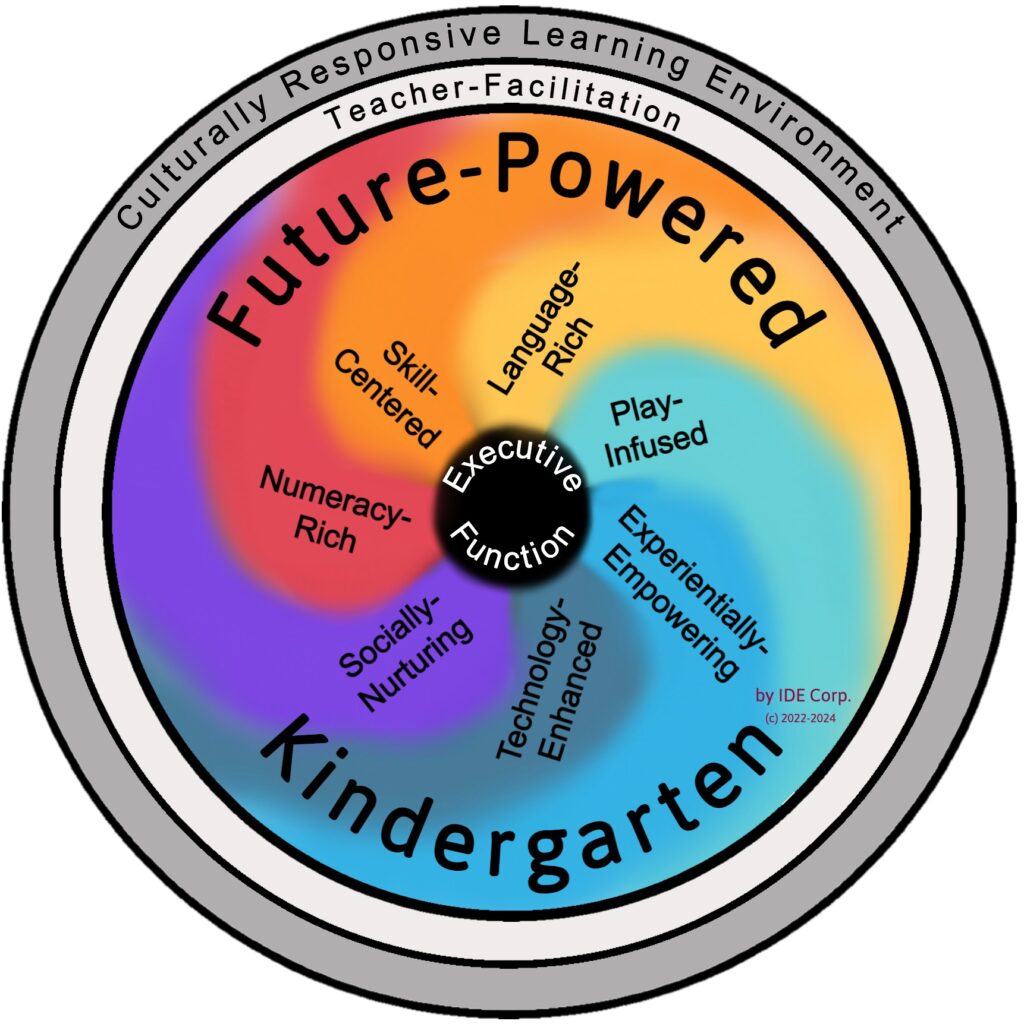A Plan for an Actionable Response
What will it take to turn the “Portrait of a Graduate” from a vision to a reality? Let’s break it down so you can use it to drive curriculum design. We’ll look at the following:
- – The common Portrait of a Graduate attributes across states and districts
- – How curriculum can be designed to achieve the Portrait of a Graduate promise
- – From 12th-graders to kindergarten students: what you can do to help them achieve the promise of the Portrait of a Graduate
Where We’re Headed: A Look at the Portrait of a Graduate
Looking across states and other countries, the following attributes seem to be universally desired:
- Analytical Thinking
- Critical Thinking
- Problem Solving
- Creativity
- Innovation
- Communication
- Collaboration
- Self-Awareness
- Self-Direction
- Resourcefulness
- Resilience
- Flexibility, Adaptability, & Agility
- Social Awareness
- Ethical Reasoning
- Global Citizenship

How the Curriculum Can Promote Your Portrait of a Graduate Vision
While I could create this chart for individual subject areas, for the sake of this blog, let’s look at a few characteristics that can be applied across the curriculum. You’ll see an emphasis on a project-/problem-based approach to learning (see my 6 Ps of PBL video — what’s up with the short hair?).
That’s because the world of work and life itself is not about tackling disconnected tasks; they’re driven by problems, projects, and goals. Why isn’t school?
Questions to Consider
Do we want to graduate compliant students or efficacious human beings?
Do we want to graduate students who just accomplish tasks because someone said so or because they embrace the “why” of the learning and want to accomplish it?
Use these questions as you conduct classroom walkthroughs or reflect on your own classroom. Which are you producing? And, BTW, I’m talking pre-K and up!
Charting It Out!
| Attribute | Written Curriculum | Instructional Implementation |
| Analytical Thinking | Rather than teaching incremental skills and building upon them to achieve the curricular goal, have students break down big ideas and skills as to why they’re important and what component parts they need to master to be successful. | Begin each new topic with deconstruction time, best accomplished in small groups and including the use of AI to examine the “why” and “how” of the topic. |
| Problem Solving | Present clustered curricular topics as problem- or project-based tasks that compel students to learn the curriculum to produce a solution. | Launch each unit of study with a compelling challenge supported by facts, images, and statistics that make students go “Whoa, we have to tackle this!” Teach skills after students say “How?” or “Help!” in order to develop the solution. |
| Critical Thinking | Include evaluation of multiple perspectives and solutions to problems that already exist or their colleagues’ solutions to problems. | Have students evaluate, compare, and question other approaches, opinions, and perspectives relative to the content and its use in the real world, including peer review of one another’s ideas and solutions. |
| Creativity | Include opportunities for students to ponder creative application of content to the world around them and ideas that even an AI bot can’t come up with! | Provide time for students to daydream (great article on 18 habits of creative people; build as many as you can into the learning day). |
| Innovation | Ensure problem/project scenarios include a real-world audience with the development of a solution, not just a discussion of ideas. | First, you present the PBL challenge. Then you provide opportunities to learn based on students’ identifying what they need to learn to create a solution. Have them keep a Designer’s Journal or (elementary) External Brain to capture ideas but not detract from the curricular learning. Then provide time at the end of the unit to assemble their solution presentation in whatever format is appropriate. |
| Communication | Incorporate tasks that require students to express ideas clearly and effectively across various modes (oral, written, visual, digital), with explicit instruction in audience awareness and tone. | Provide practice in presenting to varied audiences, using multimedia tools, participating in structured discussions, and responding to feedback. |
| Collaboration | Structure curriculum to include co-created projects, peer partnerships, and interdisciplinary tasks that rely on shared responsibility and consensus-building. | Intentionally group students to build team dynamics; teach roles, norms, and accountability structures to support effective group work. |
| Self-Awareness | Integrate regular opportunities for self-reflection, self-assessment, and goal-setting related to the content, helping students recognize their strengths, learning styles, and areas for growth. | Use tools like Efficacy Notebooks, learner profiles, and check-ins to support students in identifying and articulating their needs, emotions, and progress. |
| Self-Direction | Include scaffolded student voice, choice, and independent learning pathways that gradually release responsibility to the student for setting goals, managing time, and evaluating outcomes. | Provide planners, goal-setting templates, checklists, and active teacher facilitation while gradually reducing teacher-led guidance as students demonstrate greater independence. |
| Resourcefulness | Present resources for students to utilize in tackling the curricular content, but also provide challenges to locate other resources. | Incorporate a resource area where students can go (physical or digital) to access resources; encourage students to design “how-to” sheets and locate other resources to be added to the collection. |
| Resilience | Incorporate iterative tasks and feedback loops that normalize revision, failure, and persistence as part of the learning process. | Engage students in iterative tasks where revision is expected and feedback is part of the process. Utilize an Efficacy Notebook to reflect on what didn’t work and what to try next. Highlight stories of persistence in real-world contexts and use classroom language that normalizes struggle as part of learning. |
| Flexibility, Adaptability, & Agility | Design tasks that evolve over time or include unexpected variables, requiring students to shift approaches, reevaluate decisions, and manage ambiguity. | Create dynamic learning environments with shifting expectations, role-playing, and scenarios that require students to pivot and revise plans. Have students challenge one another with “What if?” questions on their proposed solutions. |
| Social Awareness | Present content-related challenges that reflect real-world contexts that require students to understand and consider the perspectives, needs, and cultures of others, including current events and community issues. | Use literature, simulations, guest speakers, and community engagement projects to deepen understanding of others’ experiences and social contexts. |
| Ethical Reasoning | Include the step of thinking about what happens to people and the environment if we don’t tackle the problem. Introduce related ethical dilemmas and case studies across disciplines that require students to weigh values, make informed decisions, and justify their reasoning. | Guide students in structured debates, ethical reasoning frameworks, and discussions that explore consequences and moral choices related to the content and/or its application in the real world. |
| Global Citizenship | Utilize global challenges or international collaborations that require students to engage with issues of global importance and interdependence. Incorporate the UN Sustainable Development Goals into lessons and challenges. | During teacher facilitation, ask students about the impact of the curricular topic, their actions, and their solutions on the classroom, school, community, state, nation, world, and, hey, outer space! |
The Train Has Left the Station
Your current 10th- and 12th-graders have precious little time to spare to achieve your Portrait of a Graduate. Engage teachers in deciding which “Instructional Implementation” ideas they might incorporate into their classroom activities. That might include having students deconstruct your Portrait of a Graduate and assess their readiness for the real world!
Your 9th- and 10th-graders are so close to graduating, BUT you have time to modify one or more subject-area curricula to incorporate some of these ideas. No time to waste!
Igniting the Passion in Gen Alpha
Your 4th- to 8th-graders are perfectly poised to shift to a more problem-based approach to instruction. This generation of Gen Alpha students are problem-solvers, socially conscious, ready for autonomy and choice, and, for the most part, fearless. Take your curriculum, and for each unit of study, have teachers consider: “What real-world challenge could students tackle if they knew this content?” Then start the unit by presenting that challenge to build a “felt need” for learning. Use an AI chatbot to help brainstorm real-world connections and keep asking it for more ideas, more real-world, more connected to the curriculum, etc. (Never stop at the first answer with AI. It’s not Google; it’s a conversationalist! Mine is named Nex, short for Nexus.)
The Formative Years
Your 1st- through 3rd-graders are in that wonderfully developmental stage of content mastery. This is the time to bombard students with questions! Watch as they engage in activities, in play, with one another . . . and ask questions: Why? What if? How come? You can lay the foundation for the Portrait of a Graduate beautifully in these grades even if you don’t take a PBL approach (oh, and I recommend you do, but I get so much pushback at those grade levels . . . but do watch a video playlist of an elementary school that did! . . . and showed awesome academic gains).
Future-Powered Kindergarten

Kindergarten and pre-K are just the best places to start your pathway to the Portrait of the Graduate because these students have not yet picked up the habits that need to be reversed across the rest of the grade levels: whole-group compliance instruction, it’s “B” day for everyone, wait for the teacher to take attendance, wait for the teacher to tell you what to do. Nope! You can #DoSomethingDifferent
For more on Future-Powered Kindergarten:
Ask Nancy (oh, that’s me!)
I hope this blog post has given you food for thought. It occurs to me that it may prompt a few questions as well . . . so feel free to send them to me and I’ll either respond directly or combine similar questions into a follow-up blog.
And now . . . make today ridiculously awesome! (Tag line borrowed from Consuela Style.)
